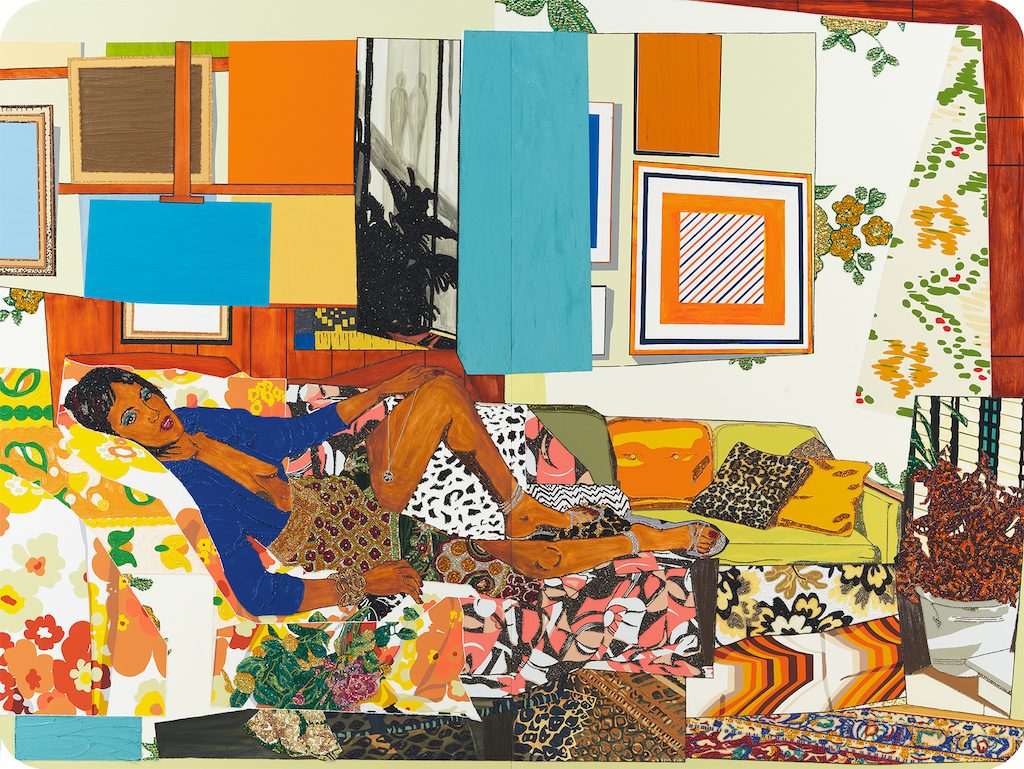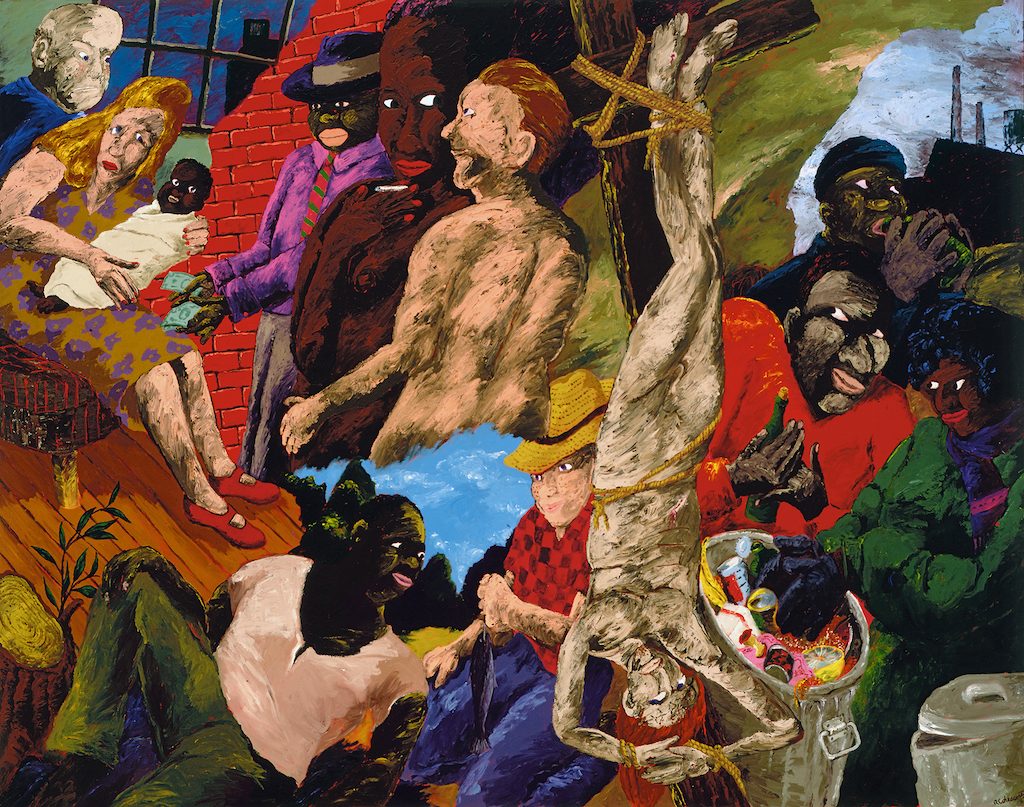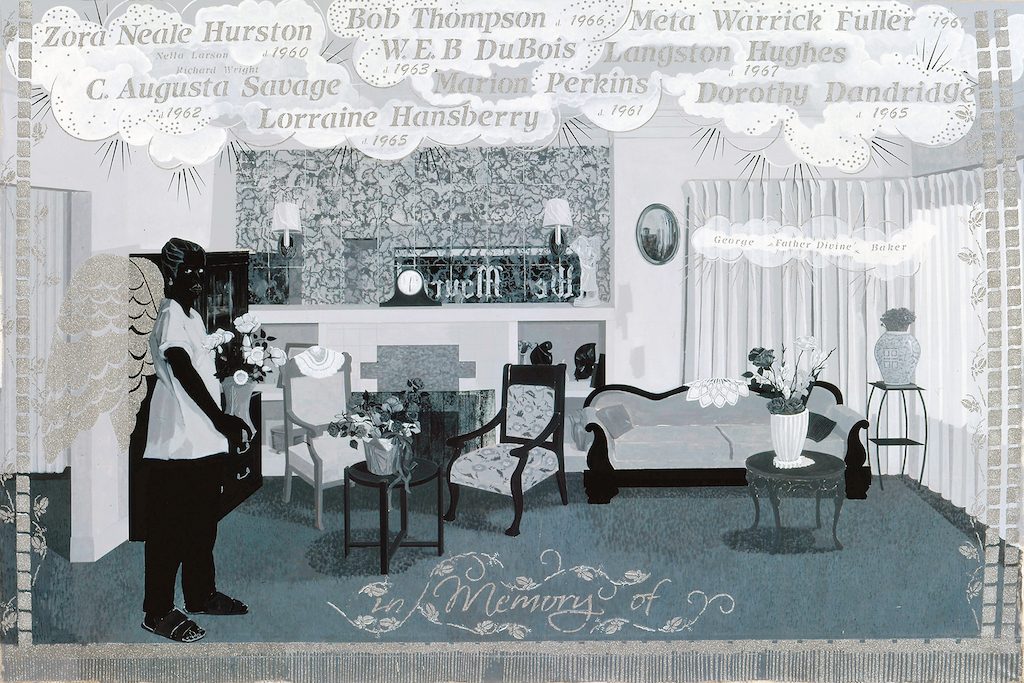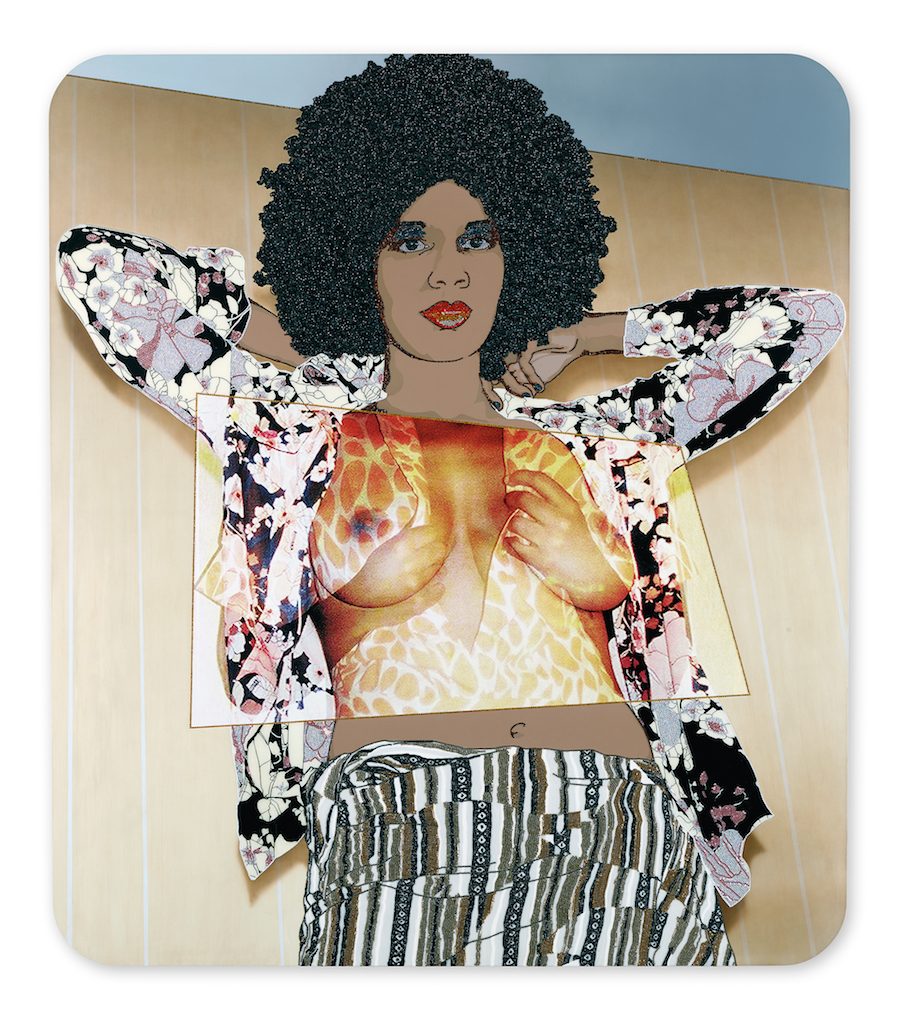at the Seattle Art Museum
Reviewed by Lorraine Heitzman
Figuring History, at The Seattle Art Museum, raises the question, “How do we perceive that which isn’t there?” For Robert Colescott, Kerry James Marshall, and Mickalene Thomas, that is not a rhetorical question. For these three generations of African American painters, the absence of people of color in art was personal. Their ability to tell their stories with such verve and conviction and their choice to break through conventions about whom and what should be represented in art has transformed art history. Each artist faced the challenge differently but together their work shifts the paradigm of race and representation in museums towards a more inclusive record of what it means to be American.

Robert Colescott, the de facto elder statesman of these three artists, was born in Oakland, California in 1925 and died in 2009. In his most well known paintings he mimics famous artworks, substituting blacks for whites, in a shrewd indictment of the Eurocentric hierarchy in museums. Other paintings take on race relations and sexual mores with rollicking, entwined figures that recall the complexity of WPA murals combined with the freedom of the Jazz Age. Colescott served in the army in France and Germany during World Ward II and upon his return he attended San Francisco State with an interest in international studies. After learning that there weren’t opportunities for African Americans in the diplomatic corps, by the time he transferred to U.C. Berkeley two years later, he was an art major.
Following graduation, Colescott went to Paris to study with Ferdinand Leger for a year, an experience that had a profound effect on him. Leger steered him away from abstraction towards figurative work and the subsequent narrative style for which he became known. Colescott has said that the most important insight he gained from Leger was how to achieve a sense of monumentality. Later he returned to Berkeley to get his Masters degree and then travelled and worked overseas before settling down in the Bay area by the late sixties.

When Colescott moved back to California, his paintings were colorful, bombastic, cartoon-like narratives influenced by popular culture. Despite the tumultuous times and the encroaching counter culture, there were scant precedents of the sort of paintings that Colescott began making next. His historical paintings, re-imagined with African Americans, were a brilliant first step towards influencing the way the public thought about race. In an oral history interview that he gave to the Smithsonian in April 9, 1999, Colescott claimed that twenty-five years after he had painted his groundbreaking work, George Washington Carver Crossing The Delaware: Page from an American History Textbook, appropriation was a dead issue. But in Roberta Smiths’s obituary for him that appeared in the New York Times ten years later, Smith categorically states, “ No American painter of the late 20thcentury made such telling use of painting’s European past to lambaste the painful contradictions of the American present.”
Colescott passionately believed that “the way you serve art is by being true to yourself.” His vibrant, uninhibited paintings are an honest and humorous look at black history, and his real and imaginative interpretations, rarely seen on the scale he painted, paved the way for Marshall and Thomas.

Kerry James Marshall, who grew up in Los Angeles and now lives in Chicago, is a likely successor to Colescott. He, too, wanted his paintings to reflect his truth. To challenge the status quo, Marshall understood that he needed not only to make artworks that would depict people and circumstances that were antithetical to the holdings in most art institutions, but that he also needed to create work that would get past the gatekeepers (the museum boards, collectors and curators) by virtue of their quality, or as he would say, their “mastry”.
In a conversation with the chief curator of the Museum of Contemporary Art, Helen Molesworthy in March 2017, Kerry James Marshall states, “ It’s psychologically damaging to continue to go (to museums) to observe other persons in a place of privilege and never finding yourself able to get there. That’s psychologically damaging…Seeing reflections of oneself matters.”

From early on, Marshall wanted to make art and to see himself reflected in art museums. To make that happen, he went to Otis College of Art and Design in Los Angeles in 1977. And even though performance art, conceptual art and installations were trending at the time, he felt strongly that there was unfinished business in painting regarding the lack of black representation. Over the next thirty-five years, he has addressed the challenge, expanding the canon of African American art in museums while increasing the complexity and specificity of his subjects in his work. He has painted multiple series of paintings, from public housing projects, beauty salons to home interiors, each featuring black figures as subjects and objects of affection. In his Vignette series at SAM, five paintings loosely based on Fragonard’s Rococo painting, The Swing, Marshall captures two young lovers kissing on a stoop. He then breaks down their embrace over several canvases as the man lifts and swings his girlfriend. It is a subject rarely addressed in art: two African Americans teens behaving affectionately towards one another. The paintings are predominately white with black lines, giving them the feeling of a Dick and Jane primer. If they have a slight didactic quality about them, it was undoubtedly the artist’s intent because he is surely teaching us something. “Here is how we do a swing” he seems to be saying, his point is clear, even if the reference to Fragonard may not be so apparent.
Kerry James Marshall’s stark, silhouetted figures set against brilliantly colored interiors or exteriors, exemplifies his ability to harness complex compositions and palettes. While simultaneously emphasizing his subjects and their environments, he masterfully constructs his paintings with a two dimensionality that is reminiscent of folk art or early American paintings. Marshall wants to engage with the viewer, to connect and make his intentions known. To this end, he has succeeded in making works that are inclusive of a larger audience as well as producing paintings so carefully crafted that they are stimulating, both visually and intellectually.
As the third artist in Figuring History, Mickalene Thomas has clearly accepted the baton from her predecessors, Colescott and Marshall. By adding her feminist point of view to their irreverence and understanding of art history, she is able to focus on the lives of black women while remaking art in her own image. In a somewhat counterintuitive way, her gregarious, larger-than-life paintings, installations, and collages are intimate portraits of private moments.

Born in 1971 in Camden, New Jersey, Thomas spent her high school years in Portland, Oregon. She was drawn to art and theater in her teens, but studied pre-law until she came face to face with the work of Carrie Mae Weems. Thomas saw Weem’s Kitchen Table series at the Portland Art Museum and was moved by seeing the image of a black woman in a museum for the first time. That moment of recognition, she has said, was a catalyst for her decision to become an artist. She ultimately went to Pratt Institute and later, Yale University, but when she began to study painting, she found her subject close to home. A painting she made of her mother, a former model as well as a drug addict, opened a door for Thomas. Although her mother was a complicated muse, she was a compelling figure and has been an important part of her work since graduate school. Besides devoting her work to representing black women, she explores notions of beauty and the power of the female gaze from both the perspective of the viewer and the model.
Thomas’ heroically sized paintings are meant to dazzle. They are resplendent with rhinestones, glitter and brilliant colors, with interiors as compelling as her figures. In her 2010 painting, Le déjeuner sur l’herbe: Les Trois Femmes Noires, Thomas substitutes three clothed black woman for the two gentlemen and naked woman immortalized in Edouard Manet’s famous work. Her models look directly at the viewer and their bearing is confidant despite the fractured quality of the background. In a 2012 interview with ARTINFO, she talks in depth about the authority of the gaze that she likens to a mirror. The sitter (her model) has a powerful gaze; “You see me, therefore I exist.”

Thomas has, by her own admission, been influenced by such artists as Tom Wesselmann, Romare Bearden, and William H. Johnson. You can see their influence in her work, but she has come about her sexualized figures and abstracted interiors honestly. Her interest in installations and decoration evolved through her process.She begins many paintings by photographing models in her studio. Eventually this led to constructions of tableaux with furniture, lamps, wallpaper, textiles and wood paneling.The built environment became increasingly important, referencing memories of her grandmother’s and aunt’s houses and evoking a specific time period. Thomas began integrating her photo set pieces into her paintings and then eventually into installations that accompanied her shows. In Figuring History, there is an installation of a lounge in front of Ledéjeuner sur l’herbe, replete with carpet, seating, books and pillows. Thomas wants the viewer to be able to contemplate the work and participate in the installation at the same time. She hopes they imagine themselves in her interiors so that the viewer becomes the object of their own gaze.
Another element that reoccurs in her work is that of collage, both as a technique and as a sensibility that values bringing disparate materials and opposing ideas together. For example, as much as Thomas’s work is about notions of beauty, she believes that the reverse is also true. It is about ugliness, too, reminding us that achieving the conventions of beauty is not pretty, but is often painful. Collage is also the way she began making art prior to art school and an important component of her installations. The process of layering different materials together to infer domestic spaces helped her create the tableaux that were both familiar and familial; these were the elements of interiors that she knew, another form of recognition. Her paintings also will often include blocks of pure color, as if collaged onto the surface, calling attention to the abstract, two-dimensionality of the work. They bring to mind the quilts of Gee’s Bend and Matisse’s Cut-Outs, highlighting the artifice of painting, as if to remind the viewer that the reality is the artist’s construct, nothing more.
Figuring History is as visually stunning as it is historically significant. For Robert Colescott, Kerry James Marshall and Mickalene Thomas, the show is validation that they succeeded in their passionate quest to make themselves visible. These artists matter and their art will be a beacon for us all, for those who write the histories and create the shows and for those are able to see themselves represented in museums for perhaps the first time.
Slide Show
Colored TV, 1977, Robert Colescott.
Les Demoiselles d’Alabama: Vestidas, 1985, Robert Colescott.
Knowledge of the Past is the Key to the Future: Upside Down Jesus and the Politics of Survival, 1987, Robert Colescott.
Knowledge of the Past is the Key to the Future: Some Afterthoughts on Discovery, 1986, Robert Colescott.
Souvenir I, 1997, Kerry James Marshall.
Souvenir III, 1998, Kerry James Marshall.
Monet’s salle à manger jaune, 2012, Mickalene Thomas.
Portrait of Maya #10, 2017, Mickalene Thomas.
Racquel: Come to Me, 2017, Mickalene Thomas.
Resist, 2017, Mickalene Thomas.
[paypal_donation_button]
Lorraine Heitzman is an artist and writer living in Los Angeles. She has written about the local arts community for ArtCricketLA and Armseye Magazine and is currently a regular contributor to Art and Cake. In addition to exhibiting her art, Ms. Heitzman has her own blog, countingknuckles.com, and her art can be seen on her website lorraineheitzman.com









